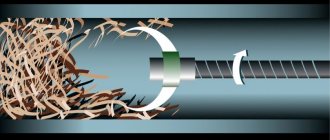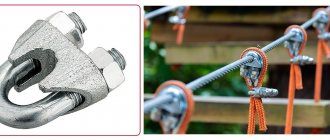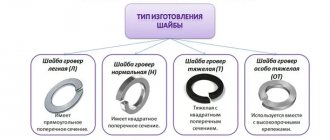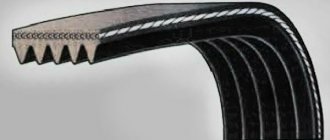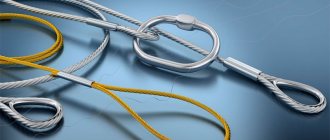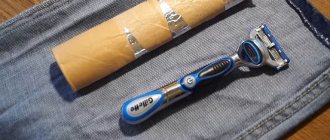I once read in a book that all the main knots known to us were used by Stone Age man. Many centuries have passed since then, and even more than one millennium has passed, the number of knots known to specialists has reached thousands and, nevertheless, what kind of miracles and inventions can you see when a modern person has the need to connect two ropes or tie a rope to stick or nails! The ropes get tangled, more than there is left, and, nevertheless, everything creeps and falls off, and when the need arises to untangle what we ourselves have woven, then without an ax the task turns out to be extremely difficult to solve, and we resort to a well-known method, which is also not born yesterday. But in peaceful life, that is, our everyday life, our life, or the life of a comrade, a different picture on a campaign, rarely depends on the quality of the tangle we have tangled. But I hope that a person who finds himself at least once in field conditions, even just in the field, realizes the need to eliminate his illiteracy quite quickly, returns to peaceful life and begins to look for books. Having shown some persistence, he finds them; as a rule, these are either books on maritime affairs or books related to mountaineering. In any of them, even the simplest one, there are a hundred different knots, according to the methods of knitting according to their purpose and appearance. If several books are taken, then the number of node names increases sharply; the number of nodes themselves, however, may not increase, since almost every node has two, three, and sometimes even more names.
Each author selects those names that are closer to his heart and the variety of combinations tends to infinity. But this is not even the most important thing, the most important thing is that each creator of the book gives his favorite knots, calls them “objectively, the best and most reliable”
. There are as many such assessments as there are authors. It’s almost impossible for a mere mortal who finds himself in this sea of names and interweavings for the first time to figure it out, since he, of course, can tie all the knots if he wants, but everyone can experience it...
Actually, it was this variety of problems that made me want to write what you are reading now. I cannot count myself among the great experts on knots, my knowledge in this area comes down to five or six books I’ve read, I myself recognize about a hundred knots, and I knit, almost without thinking, about fifty. But one day I sat down and thought: how many and what kind of knots do I use in a real, camping situation?
Actually, this is how the set I offer below came about. Naturally, it can cause a barrage of completely deserved criticism; not only are there missing individual, very popular knots, but there are not even entire classes of knots, such as knots for shortening tackle, or bayonets. I apologize, of course, but I don’t use bayonets! Well, I haven’t had to shorten the rope with a special knot in the last ten years!
In general, I would like the set that I posted here to be perceived as a starter set, the minimum necessary. I really hope that a person who has mastered this ten, like a child who has learned to read syllables, when encountering new nodes, will add them to his collection and after a while will be able to formulate and present a list of his favorite nodes, which, most likely, will be seriously different from the one presented me.
↑ Basic titles
So, let's begin.
The first issue we need to resolve is the issue of terminology. The terms, with the exception of some common to all, vary greatly. It is practically impossible to find two books in which they all coincide, so do not be surprised if you encounter a completely different alphabet in some other publication. The first essential question is the ends of the rope. It is known that a rope, like a stick, has two ends - one which you are going to knit, the second either somewhere far away or already tied to something. This is actually where they differ. Accordingly, the one that is not available to us, or we have designated it as inaccessible, will be called the root end
, and the one that will take part in mating will be called the
running end
, that’s what it was called long before us, this is an established and familiar term, I don’t see the point in inventing my own.
Further, in terms: what is an open loop
,
the loop is closed
and
the half-knot
is clearly visible from the drawing, it is much more difficult to explain in words, so try to download this drawing. Moreover, discrepancies with other authors may already begin here.
It’s a little more complicated with the node elements shown on the right side of the picture. Here everything is completely scattered, so we will still agree like this:
- out
when the running end is circled around something and its ends do not intersect. - a slag
when the running end has gone around the obstacle 360 degrees and is looking where it was looking before we started performing this element. - A half-bayonet
is a reworked run-out or an incomplete hose. The running end has already gone around the main end, but has not returned to its original position.
The half-bayonet and half-knot in some publications are considered to be the first simplest knots, and at some moments they can indeed be perceived as such, but for us now they will only be elements, with the letters of which we will form words - knots.
Materials and types of cables
As stated above, all cars and trucks should be equipped with the correct car tethers. However, before purchasing it, you need to at least partially familiarize yourself with the offered range and select the most suitable modification.
Metal tow ropes
Metal cables, the length of which complies with traffic regulations, have an advantage over others, namely strength. But there are also significant disadvantages, the most significant of which is the risk of injury. Since if the integrity of the cable is broken, both the car and third parties in the immediate vicinity can suffer. Among other things, it takes up a lot of space.
Length of synthetic rope when towing
Automotive synthetic cable is considered the most common. Its dynamic abilities and strength of synthetic fibers are quite a bit inferior to metal ones. They can be used for towing SUVs, since the quality of the material is quite suitable for such purposes.
Towing rope - length according to GOST
Parachute line as a cable
The parachute line can be used as a tow rope. Since it has excellent qualities such as elasticity and is not subject to tearing. But for all its attractiveness, the price of such car cables is very high. Therefore, before purchasing a lanyard for passenger cars, you need to think carefully, although the safety is worth it. Make the right choice, otherwise as the popular saying goes: “The miser pays twice.”
↑ Mark Knot
Brand, stage 1
Brand, stage 2
Brand, stage 3
Mark, ready
Before we begin to disassemble the main nodes, I would like to introduce you first to one specific node -
Mark
. Designed mainly to secure fibers at the end of a cable or to fasten the ends of ropes against accidental unraveling. Mark, like other units, a carriage and a small cart, the version of the unit that I present to you is apparently the simplest and this, apparently, is its main advantage, since it does not differ in increased reliability, although the ties for the frame with marks on the ends serve much longer than without them.
Tying such a brand is not difficult. The first step is to lay a loop along the tip of the rope with the loop towards the end, after which we apply tension hoses around the rope and on top of the loop we have formed. The number of turns is not important, it is mainly determined by the thickness of the thread, but, as a rule, the length of the mark is one and a half to two diameters of the end being processed. Once we have approached the tip, we put the running end into the loop and tighten it under the applied turns. The crosshairs of the ropes should be approximately in the middle of the mark, after which we cut off the protruding ends of the threads.
↑ Straight Knot, Reef Knot, Tight Reef Knot
The first of the main nodes will consider the
Direct
. Apart from the figure eight, which we will meet below, this is the only node that does not have a second name. Already the reef one has some other names, I just don’t remember them, but I’ve seen them. The knot is the most famous and, perhaps therefore, one of the most scandalous. The advantage of the knot is its simplicity: two half-knots directed towards each other, which form two mutually penetrating open loops.
Disadvantage: creeps under load, especially on modern synthetic (read: slippery) ropes, or if applied incorrectly.
Purpose: to tighten the two ends of the rope when it is necessary to tighten something, for example, to pull a backpack to the frame, to tie up some kind of bundle. Actually came from here
Reef node
. Its original purpose is to tie part of the sail to reduce the area. The straight sail, like the reef sail, copes with this task exemplarily, but the sails must not only be tied (take reefs), but also quickly released when the wind weakens, so the reef sail, unlike the straight sail, has one more loop, which is clearly visible in the figure . When forming the second half-knot, one of the running ends is simply folded in half, then we get the effect of Grandma Little Red Riding Hood: you pull the string...
But is this always good? Even a twig can pull a string while hiking. Then the following improvement of this unit appeared: we put the running end, which did not participate in the formation of the additional loop, into this very loop. We pull everything together and get a small neat knot. I have not seen this last knot in the literature, so I don’t know its correct name, we call it Tightened Reef
. We use a tightened reef for tying gondolas to the frame, not just one, of course, but in a set with other units, but it is the final one.
Main characteristics
To choose the right cable for towing a car, you need to rely on the key characteristics and features of the product. Many people are too relaxed about buying this item, throwing it into the car just because it’s necessary. But when it comes down to it, it turns out that the cable is of the wrong length, is poorly fixed to the car and cannot withstand even a slight load.
This is a really useful thing that can help out a motorist at the most difficult moment. The tow rope can be rigid or elastic. When it is flexible enough, it is able to gradually take on the load rather than making sudden jerks. It is also important to understand the differences between the materials used to make tow ropes.
The most significant characteristics when choosing are:
- material of manufacture;
- length;
- load;
- fastenings;
- color;
- manufacturer.
To make the right choice, each of the presented characteristics should be studied separately. This will allow you to understand what criteria you should pay attention to.
Material
The first criterion that you should pay attention to when choosing a tow rope is the material it is made of.
Modern tow ropes for cars can be made of:
- aviation nylon;
- ship rope;
- fabrics;
- become;
- polypropylene.
There is a difference between them. Therefore, there is no need to rush into making a choice. You need to understand what each of the presented materials can provide for a tow rope, and how suitable they are for certain cases.
- Capron. When using aviation nylon, a material of increased strength is used that can withstand significant tensile loads. This is the highest quality nylon, capable of coping with extreme situations and not tearing. Many rightly claim that products made from aviation nylon are the best solution on the modern market of automotive accessories. At the same time, the material is able to cope with loads created under the influence of moisture, frost and extreme heat. Even despite the load, fiber stretching does not occur.
- Rope. Towing ropes based on a ship's rope are also deservedly popular. Such products are not afraid of moisture, which can be considered a serious advantage. Ropes of this type are stored under any conditions and are suitable for use throughout the year. But strong loads will contribute to the gradual stretching of the product. Therefore, the service life during active use is limited.
- Textile. Most often, fabric towing cables are found in passenger cars. The fabric can be plant-based or synthetic. If a strong tension occurs, exceeding the maximum load, the product does not stretch. The cable will immediately break at its weakest point. Such products are made in the form of a soft tape, and therefore a sharp break is not capable of causing damage to a machine or person. But here it is important to consider that the fabric perfectly absorbs moisture. If the cable has been used in snow or water, it should be washed and dried after use. It is recommended to use plastic bags for storage. At the same time, the cable is compact and inexpensive.
- Steel. A tow rope made of metal wire is well suited for an SUV due to its increased strength. But this is the only significant advantage of the product. Under heavy loads, ruptures occur that can cause significant damage to the car and person. We must not forget about the negative impact of corrosion and the gradual formation of traces of rust on the surface. Because of this, storage rules must be strictly observed. The disadvantages also include poor bendability of the structure and the need for a large amount of space in the car. Therefore, steel structures are used in the absence of a worthy alternative.
- Polypropylene. The material is lightweight and elastic, it stretches perfectly and returns to its previous shape. This feature makes it easier to rescue cars that are stuck in the mud. If the driver accelerates sharply and makes a jerk, polypropylene is able to dampen the jerks. But experienced motorists advise not to use non-woven types of polypropylene products, since they will gradually wear off on themselves.
Each material has certain characteristics, strengths and weaknesses. Therefore, there is no need to dwell on this criterion. There are several more important characteristics that will be key in choosing a truly high-quality, suitable and effective tow rope.
Length
If you have roughly decided on the material, you need to look at the next question. Selecting the correct and suitable length of tow rope is extremely important. This will allow you to safely tow cars or get towed yourself.
The cable is selected based on the dimensions of the vehicle, but not forgetting to rely on the current requirements of the Road Traffic Rules.
And here it is important to understand that there are rules for cars and trucks.
- Cars. This also includes various crossovers and SUVs. There is an article in the traffic rules according to which towing ropes must have a length ranging from 4 to 6 meters. There are no clear restrictions here, but the length should definitely not exceed 6 meters, or be less than 4 meters. This range is easy to explain. It is 4-6 meters that is the optimal indicator that allows for safe towing. A minimum of 4 meters creates a gap between the cars, thereby allowing the person behind to press the brake pedal in time. But you shouldn’t go beyond 6 meters, so as not to complicate maneuverability.
- Freight transport. If we are talking about the configuration of a truck, then the traffic rules have their own rules for such situations. If passenger cars can use a flexible and inflexible coupling, then in the case of trucks only the second option is allowed. Here it is required to use a rigid coupling no more than 4 meters long. This will allow you to firmly fix the car and fully repeat the maneuvers of the vehicle that is pulling the truck.
Now you know how many meters a proper car tow rope should be. It is strictly forbidden to violate these traffic rules. It's in your best interests.
But the length does not yet form a complete picture of the right choice. You also need to understand the permissible loads and the fastenings used. Some people underestimate the role of the color of the product, although there are some very significant nuances here.
Load capacity indicators
The previously discussed characteristics largely influence what loads the tow rope can withstand. Durable material and suitable length allow you to correctly distribute the weight of the towed vehicle and complete the task without any problems.
Before choosing a tow rope for your car, pay attention to the load capacity ratings. Usually the manufacturer indicates them on the packaging. But these numbers do not always correspond to reality. Some companies try to deliberately overestimate the capabilities of their products. Buyers suffer from this, as the cables break and become unusable.
If your vehicle weighs about 1.5 tons, then choosing a cable with a load capacity of 1500 kilograms for it would be absolutely wrong. When towing, you should additionally take into account the current weather conditions, the slope of the road, and the levelness of the area. It is not always possible to tow a car in compliance with all the rules, which is why the actual load on the cable increases. As a result, ruptures occur, since the product simply cannot withstand the stress and breaks.
Imagine that the car is stuck in dense mud or in a large snowdrift. Here the real load immediately increases, since you have to not just pull the car behind you, but pull it out of the most difficult conditions.
It is recommended to always buy cables with a safety margin. Typically the margin is at least 25-50% of the car's weight. In general, it is better to take into account not only the weight of your car, but also the weight of the vehicle that you yourself can pull.
Therefore, for cars weighing 1.5 tons, it is recommended to take a cable with a load capacity of 3000 kilograms and above. If the car weighs about 2 tons, then throw a high-quality cable with a load capacity of 5 tons into the trunk.
Fastenings
When an emergency occurs, even the presence of a cable does not always help the motorist. And the problem here is trivial. Many people simply do not know how to properly tie a tow rope.
This is where knowledge of some nodes comes to the rescue. It's not difficult to learn them. But not everyone is ready for this. Instead of teaching how to tie a steel tow rope, they opt for faster and more convenient solutions.
There are several options for attaching towing, ranging from a standard loop to quick-release carabiners. Not everyone knows how to tie a loop, since the tug requires using the correct tying patterns. If you do not know how to tie a loop on a cable, it is better to use carabiners and hooks. It is a mistake to think that a rope tied in a loop holds better.
When the cable is tied using a loop, this option is the most primitive. But without a certain dexterity and ability to do everything right, it will not be possible. If you do not fully understand how to tie the tow rope, the loop may come undone at the most inopportune moment. It’s not for nothing that experts call hinges the least reliable method of fixation.
When the hinges are used repeatedly, they gradually wear out due to contact with the metal eyelet. It’s one thing if the beginning of a rupture was noticed before towing. And if the loop breaks while moving, the consequences can be very different.
To get a truly reliable hitch, it is better to use carabiners or metal hooks. These are stronger and more durable connection options. Plus you don't need to spend a lot of time on installation. This is done in just a few seconds.
The carabiners are equipped with latches designed to prevent the loop from slipping off when towing the vehicle. Here the loop will not break at the wrong moment, unlike a standard fastening without hooks or carabiners.
But the same hook has a weak point. This is the area where it connects to the cable. Therefore, it is important that the most reliable firmware or fixation be used. If you choose high quality products, there will be no problems with tears in weak areas.
The role of color and manufacturer
It would be better if the motorist buys a high quality towing rope so that the car can actually be pulled out without any problems. But it’s difficult to say for sure which cable is the best. The towed car must have confidence in the quality of the coupling and the reliability of the product connecting the two cars.
There are several manufacturers that can claim to be the best in Russia. They produce both rope cable made from special ropes, as well as polypropylene, nylon and other types of products.
Although the manufacturer of tow ropes does not play a decisive role in the choice, it is worth paying attention to the most popular companies on the market. These include:
- Burlak;
- Auto Rope;
- Airline;
- Expanta;
- Promtek.
These companies have proven that they are capable of producing high quality products. Their range is extensive, and therefore everyone will be able to choose the appropriate tow rope option for a specific situation and vehicle parameters.
As for color, inexperienced motorists can only think about decorative properties. Allegedly, the color is needed solely as a decoration, a visual component that does not have any effect on the really important moments of towing.
But no. Color really plays a role in the process of towing a vehicle, and not the least. Any specialist or just a motorist with extensive experience will tell you that it is best to buy a cable made in some bright color.
Bright color is necessary for a fairly simple, but at the same time important reason. It makes vehicles that are coupled to each other using a tow rope visible. This way, drivers will know that these cars are in tow, and therefore will be able to make the right maneuvers, overtaking or letting them pass.
Also, the bright color helps the driver himself to observe how tightly the cable is stretched when starting the movement and directly during movement.
Almost all manufacturers always use bright colors when making tow ropes. Namely:
- green;
- blue;
- yellow;
- orange;
- red, etc.
But the manufacturers didn't stop there. To further increase the practicality of the cable and make it visible, special threads with a reflective effect began to be added to the product. When headlights shine on the cable when towing at night, drivers immediately notice it. This way it is possible to avoid accidents and collisions with hitched vehicles in conditions of limited visibility on the road.
If these are trucks or commercial vehicles that use metal cables, special bright signal flags should additionally be placed along the length of the product. They are also designed to increase visibility and perform well in real-world use.
↑ Figure Eight Knot
Next node
Eight
. Classic, knitted much easier than it can be described. The original purpose of the knot is to thicken the cable, and it works great for this purpose, but its main advantage, of course, is not this, you can choose another knot that will cope with the task of thickening the cable no worse, its advantage is that it is the basis of countless number of other nodes for various purposes.
For example: Counter eight
, used to connect two cables. The advantages include the fact that the knot is relatively compact, the connection of the two cables is considered very strong, this knot, even when tightly tightened, does not damage the cable, and it is relatively easy to untie. The disadvantages include the fact that the knot is somewhat “clumsily” knitted. First, a figure eight is knitted at one end, then the knot is repeated with the other end in the opposite direction, that is, the running end enters the figure eight from the side of the running end of the first cable, repeats the entire path of the first cable, and ends at the root end of the first cable.
Or the second example of Ogon with eight: Ogons
, are a class of knots that form small loops at the end of a rope or cable. The advantage of the knot is that it is knitted very simply - a figure eight tied in a loop; if you need to tie a loop around something, then first a figure eight is knitted, and then it is repeated in the same way as in an oncoming figure eight. Very often a mark of thread is placed on the fire so that the knot does not accidentally come undone. This is done only if the fire is knitted for permanent use. For example, I put one on the end of a carrot, since with a light at the end it often turns out to be easier to attach it, but tying a bowline or a towing one and the light cannot interfere.
Fabric
One of the most common materials for cables. It can be woven from plant materials or synthetics. Under heavy load, such an element does not stretch, but simply breaks. Due to the fact that it is soft (usually made in the form of a flat tape), if it breaks, it will not cause any harm to the car. Another disadvantage is that it absorbs water well. After use, washing and drying are required. It is advisable to store it in a plastic bag. The advantage is that it is very compact - it does not take up much space in the trunk.
↑ Bowline knot
The next classic knot is
Bowline
. Sometimes it seems to me that if a person knows three sea knots, then among them there will definitely be a straight one, an eight and a bowline. In my opinion, it’s not worth describing how it is knitted for the simple reason that there are a “milion” ways to tie it. But the essence of the knot does not change depending on how you tied it, nor does its work.
The only thing that is significant is how the knot will look in its finished form, and since this knot is most often used for tying oneself, a loved one, when you need to somehow secure yourself, for example, for belaying a rope, I depicted it somewhat unconventional.
In fact, a bowline is a representative of the class of non-tightening loops, and I didn’t draw the loop itself, which goes behind your back; it’s still not visible. But the knot is in the position in which you will look at it when it is ready after you tie it. A little free advice: the loop should be tightened around you as tightly as possible and raised under the very armpits, only in this way it can help if you suddenly have to use it to save your precious skin.
In general, the application of the knot is much wider. It is used wherever it is needed, and almost everywhere it works quite decently, but sometimes it gives back change for incorrect use. As a rule, it consists in the fact that when used under a load exceeding the optimal one for a given diameter of the rope, the bowline refuses to give out. If you fell and the knot saved your life, then the rope is still being scrapped and it’s not such a pity, but if you tied a four on this bowline on a six, that is, there were no jerks, the rope is quite good, then it will be cut It's a shame. But there is nowhere to go; this is the price to pay for the simplicity of the node. Of course, you can save the rope with the help of a nok
- a special wooden or metal rod that is tied into a knot in a special way, but this is a topic for a separate conversation, which I would not like to touch on now.
What to pay attention to
The tow rope is an important component. It must not only be made of high-quality material, but also have other indicators that are regulated by traffic rules.
So, for example, its length should be at least 4 and no more than 6 meters. If this figure is greater or less, then transporting a stuck or broken down vehicle will be difficult.
Experienced drivers recommend trying on the cable before purchasing and not believing the labels. Many manufacturers may indicate one length on paper, but in reality it turns out to be much shorter. Therefore, before going to the store, stock up on a tape measure and perform this important operation.
How to choose the right tow rope? After its length is measured, you need to pay attention to the material. The once popular steel option is already becoming a thing of the past; it is used less and less. But the nylon version is the most popular today.
The third important indicator is the permissible load. It should be twice, or preferably three times, the mass of the car. Before purchasing, you need to understand that sometimes you will have to tow not only passenger cars, but also SUVs. Therefore, it is better to choose the permissible load with a reserve.
And finally, the fastening. The most common type is metal hooks at both ends. This is an ideal option as they are quickly attached and do not require any special maintenance. But fabric loops can quickly fail - tear or fray. Therefore, it is better to refuse this option.
↑ Knot Vblenka, Constrictor, Bale
Now the next knot from a series of classics with a huge number of developments and continuations, but the knot is apparently less classic than, say, an eight or a straight one, both of them have the same name, but this one already has at least two of them:
Vyblenochny
or
Stirrup
. Like most classic knots, it is simple to the point of disgrace: two closed loops directed towards each other. Advantages: simple, holds very well under constant load, releases very easily, can be tightened very tightly, does not damage the rope.
Disadvantage: it crawls jerkily under load. I most often use it when tying a frame, but, as mentioned above, there are a huge number of applications, like any time-tested knot and...
But the main thing is that, like the figure eight and straight, it is the ancestor of a whole family of knots. For example, if we form a half-knot under the break, covering both closed loops, and we get a knot under the beautiful and proud foreign name Constrictor
.
The word constrictor, translated from English, means a common boa constrictor, which is completely justified. The knot is really tightened to death, and it is almost impossible to untie it. By the way, there is another knot that has one of the names Boa Constrictor
, it differs very little from the constrictor, but, nevertheless, it is still a different knot.
It is very convenient when something needs to be connected to death, but it is worth putting the running end into a half-knot with a loop and we get a new knot with the noble foreign name Bale
, but if you know that a bale is a bag, then the knot immediately loses its nobility, but acquires a purpose - tie the bags!
How to braid a rope?
The process diagram and algorithm are not as complicated as it might seem to an inexperienced person.
1. We cut off the ends of the cable as evenly as possible, and if the ends of its strands are bent or uneven, then we unravel each strand a little and cut off the defective areas with scissors or wire cutters. It is convenient to chop off the ends by placing them on a metal rail or on a sledgehammer and striking the same place with the sharp edge of a hammer. As a rule, after 10-15 such blows, the ends of the cable are cut off. 2. Unravel the cable into strands at least half a meter from the edge. 3. We determine the diameter of the future loop we need and, measuring this distance from the edge of the unbraided cable, take 2 strands. You need to add 3-5 cm to the diameter of the future loop, since it will definitely decrease in size when weaving. We make a loop from the selected strands, wrapping them. 4. Either end of the thread is untwisted and wound into intertwined strands. The other one needs to be wound in the opposite direction. If the length allows, then from the resulting three strands you can weave a pigtail, alternately weaving the threads. 5. The third strand is twisted around the braid, then a loop is woven into it, and a turn is made around the braid again. During the weaving process, the wires are passed in such a way that the previous one always goes towards the next one. 6. Then all the ends of the wires are hidden inside the pigtail, and the resulting two strands are hidden inside using a screwdriver or pliers. 7. It is advisable to tighten the resulting braid with clamps in two or three places. You can use ordinary wire, which is tightly wrapped around the cable and then pulled tightly with pliers. The protruding ends of such a clamp are also hidden inside the pigtails so that they do not interfere.
At the end of the work, it is advisable to isolate the location of the operation, for example, with insulating tape. It will help to fasten the ends of the steel wires together and will prevent future damage to the hands of the person who will use this cable.
When talking about how to braid a cable, you should remember: in order to get a strong and reliable connection, during laying it is necessary to lay the strands symmetrically and apply even pressure on them. Periodic crimping of the twisted strands will be an additional guarantee that the entire structure will receive sufficient strength.
↑ Shkotovy knot
Now let's move on to the knots that I use to tie the rope to something, for example I need to tie a ribbon to the corner of the awning.
For this I use a knot called Shkotovy
.
By the way, I would like to immediately draw your attention to the affinity, the similarity of some knots, compare the clew and bowline and find some differences, I don’t think you will be able to find many of them, even if you have a very rich imagination.
You can easily guess that the knot was originally intended to attach the sheet to the sail, if, of course, you know what a sheet is. But not everyone has the good fortune to sail, which I sincerely regret, so it’s worth explaining that the sheet is the rope that controls the sail and pulls it, that is, stuffs it. At the corner of the sail there is a fire loop, to which the rope is attached with this knot. With the same success, this knot will work on any other light, but not only this, this knot is a method of attaching to a larger end, it holds so securely that a clew is even recommended for tying two ropes of different diameters. But even this does not exhaust its possible applications. I use it very often when I need to secure a rope, for example, to the corner of an awning, or to the corner of any other rag. The only condition for reliable operation of the clew knot is that the rag must form a more voluminous end than the rope that we are going to fasten.
↑ Flat knot
Now, in fact, we can return to where we started, to the knots for tying two ropes.
It is difficult to find a knot that would satisfy all the conditions: it would be simple and reliable, and would not spoil the rope, and would also come apart easily, so difficult that, in my opinion, it is simply impossible! Therefore, I use several of them for these purposes. One of them is Flat Knot
. In its classic form it is shown in the figure. The situation is quite standard; describing in words how a knot is knitted is much more difficult than understanding it by looking at a drawing. There are no fewer ways to tie it than a bowline, and maybe more, since it also has more weaves. The knot is woven rather than knitted. It is worth noting that it best demonstrates its advantages precisely in the version shown in the figure, that is, with two marks that grab the running and root ends, in this case, the strength of the connection is not inferior to the rope itself, some complexity of preparation is compensated by super-reliability. If you don’t put the mark down, it will form into a small knot that does not crawl under any load, but in this case it weakens the rope somewhat. The relative ease of tying comes at the cost of a loss of reliability. One more thing, the knot works best on ropes of similar diameter, which does not happen every time in real life. Very often you have to tie whatever ropes you need.
Of course, you can use a counter eight, which takes time, or, say, a clew knot, but if you rush and don’t fully form it, it can creep and even, worse, fall apart. But if large loads are not expected, and the ropes are of different diameters, or very different in rigidity, or are very slippery, then you can use the Weaving
knot.
The knot is secure and easy to tie, but it seriously weakens the ropes and it gets very tight.
Should you tow or pull?
Who cares? At least in terms of price: so-called jerk cables are much more expensive than their “regular” colleagues. They can, of course, be used for conventional towing, but this is irrational: after all, they were created for something else. When the towing vehicle begins to move, the jerk cable first stretches and then sharply “shoots”, shrinking in size. An experienced tug driver, sensing this moment, usually presses the brake: in this case, the energy of the compressed cable almost entirely goes to the towed car, pulling it out of the impassable area. In practice, if the snatch cable is used for towing, it is folded in half.
Towing belt 4.5 tons 5 meters with flags
Towing belt 4.5 tons 5 meters with flags
The dynamic sling (4.5 t, 5 m) from Ufa is optimal for vehicles weighing up to 1.5 tons. The width of the tape used is 5.5 cm. The coupling type is “loop/loop”.
The dynamic sling (4.5 t, 5 m) from Ufa is optimal for vehicles weighing up to 1.5 tons. The width of the tape used is 5.5 cm. The coupling type is “loop/loop”.
Reflective flags: at least two of these must be placed. Type of fixation: double-sided Velcro. Flag size: visible - 200x200 mm, full - 400x200 mm.
Reflective flags: at least two of these must be placed. Type of fixation: double-sided Velcro. Flag size: visible - 200x200 mm, full - 400x200 mm.
Dynamic sling (4.5 t, 5 meters) “Standard”, Rigging +
Set of flags with reflective tape for towing strap/cable
↑ Towing unit
Very often the task arises of tying a rope, say, to a twig, peg or tree trunk. In this case, we will not be able to form a loop, especially if it is a tree trunk. Of course, someone might be able to do this, nothing is impossible in this world, but I think it’s worth thinking about the cost of labor and time; maybe it would be easier to master a new knot?
To solve such a problem, as a rule, I use a unit called Towing
. The advantages of the knot include its amazing reliability and careful handling of the rope, in addition, a very important advantage, it can be heard under any load. In my practice, situations have arisen more than once when the ease of untying a knot saved the rope from the knife.
For reasons unknown to me, when mastering this node, many problems always arise, although, in my opinion, this is completely inexplicable, because everything is so simple! We make a half-bayonet, wrap the running end around the root end of the rope, another half-bayonet in the opposite direction, now a half-bayonet around the root end, and into the closed loop we have formed (it is formed around the root end) we insert the double-folded running end! All!
Honestly, it seems to me that it’s worth practicing for some time and still mastering this wisdom, there is something to fight for. A little information, in order not to carry a bag with a chalk around the tree, you can knit a knot with a loop of the appropriate length.
Actually, the main knots are over, but at the end of my story I would like to share a couple of knots that often make my life easier.
Foto 1
In winter, problems with the battery often occur, forcing you to remove it to recharge. To do this, you have to carry the battery home. The weight is about a pound, the handle is either very uncomfortable or there is none at all. Carrying a battery on oneself is a challenge even for a young and strong man, let alone women and the elderly. In this situation, a wide shovel for clearing snow helps me a lot. I put the battery on it and carry it as if on a sled.
LIKE SAILORS AND CLIMBERS
V. Kashkin, St. Petersburg
↑ Bee Knot
To begin with, the conductor is a knot with a small loop in the middle of the rope. There are many such nodes, and they are all conductors, and, as you probably guessed, this is also a separate class of nodes. Guides can be extremely useful when the need arises, for example, to transport things across a crossing.
Bee stage 1 | Bee stage 2 | Bee, finished knot
This knot called
Bee
like it is shown in the picture, but it is knitted very simply: we take the rope at the place where we need a loop, and turn it twice so that we get the figure from the following picture. Next, we take the loops at the top and wrap the rope around it, as shown by the red arrow and thread it through the bottom loop, tighten it and get the knot we need, which is ready to work for us like a bee!
Ogonov
well
Alternative descriptions
• Loop at the end or in the middle of a panel mounted cable
• Roman Emperor
• A method of forming a permanent loop on a cable by intertwining its threads
• (target.
oogen literally eyes) - a sea ring at the end or in the middle of the net with which accessories are worn on the sparrow (mast, crest, etc.),
• (Border) - a song from the bass repertoire. Later he switched to the word "gon"
• Thief in Slavic mythology
• Sealing ring
• Ring on the front panel
• Ring (sea)
• m.
gorge o. old.
↑ Knot Noose
And the last knot I would like to share is the garrote. Moreover, the noose is the simplest, but that’s probably why I love it. If there are no specific requirements for reliability, load, or anything else, I use it. For example, you need to lift a bag two meters, or pull a bundle of brushwood, or fasten a rope to a tree for a short time, or pull it through the water, or place it vertically, the trunk of that same tree, and so on and so forth. However, you will find a use for it yourself if the bundle is always at hand, I beg your pardon, in your memory.
